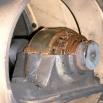Maintenance Systems
Reactive maintenance
Advantage:
-
"Drive to breakage" - this concept means little effort for maintenance; just until the machine fails
Disadvantage:
-
Increased costs due to unforeseen downtime
-
Increased staff costs, especially for jobs requiring overtime
Preventive maintenance
Advantage:
-
Fixed maintenance intervals reduce machine downtime. Compared to the reactive maintenance, a cost saving of approx. 12% (pure material input) can be achieved.
Disadvantage:
-
A Maintenance based on time intervals leads to increased staff costs and high costs for spare parts, since components with remaining service life may also be replaced.
Predictive maintenance or condition-based maintenance
Advantage:
-
The permanent monitoring detects damage to components already in the development.
-
Maintenance work is therefore carried out only as needed and can be planned in good time.
-
Compared to preventive maintenance, a further cost savings of about 18% can be achieved. Costs for machine and process stoppages are thereby reduced.
-
Costs for personnel and spare parts are also reduced.
Disadvantage:
-
The costs of traditional surveillance systems such as thermography and vibration analysis can be very high.





